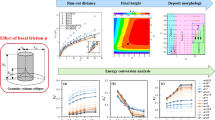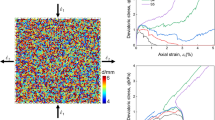Abstract
Dry granular materials have been the subject of many investigations, while wet granular materials, which widely exist in many real-world applications, have only received limited attention. The aim of this paper is to address the missing gap in continuum modeling of wet granular materials. To study the wet granular flows, a grain-scale capillary interaction is introduced, as additional cohesive stress in the continuum-scale framework. We coupled the viscoplastic constitutive law for dry granular material and cohesion model for wet isotropic granular material to capture the behavior of wet granular materials. This combined model is implemented in a smooth particle hydrodynamics framework because the meshfree nature of this method captures the large deformation of granular flows without local grid distortion. The Wendland kernel is used as the interpolation kernel to improve numerical stability. This framework is validated by comparing numerical results with recent experimental findings for both dry and wet cases. The comparisons are illustrative of the potential of the framework to capture the behavior of granular materials across different phases. For different levels of friction and water content, the run-out dynamics and shear strength properties of granular materials in the final quasi-static regime are investigated. For granular flows on flat surfaces, compared with dry granular materials, with the introduction of surface tension in wet granular materials, it is found that there are increases in shear stresses locally and globally, enabling stronger internal forces to support structures with larger angles of repose. The surface energy-induced cohesion is found to play an important role in low friction cases compared to high friction cases. To benchmark the numerical framework presented here, granular column collapses on curved surfaces are also investigated. For flows on curved surfaces, although there are also increases in internal shear stresses, the differences in final profiles between wet granular materials and dry granular materials are not as pronounced as that on flat surfaces due to geometric constraints. The findings of this work are demonstrative of the capabilities of the smooth particle hydrodynamics method for the study of wet granular materials. This effort can serve as a step forward in the quest for a unified continuum theory and computational framework of granular material dynamics.









Similar content being viewed by others
References
Artoni R, Santomaso AC, Gabrieli F, Tono D, Cola S (2013) Collapse of quasi-two-dimensional wet granular columns. Phys Rev E 87(3):032205
Bui HH, Fukagawa R, Sako K, Ohno S (2008) Lagrangian meshfree particles method (SPH) for large deformation and failure flows of geomaterial using elastic–plastic soil constitutive model. Int J Numer Anal Methods Geomech 32(12):1537–1570
Campbell CS (1990) Rapid granular flows. Annu Rev Fluid Mech 22(1):57–90
Chabalko C, Balachandran B (2013) GPU based simulation of physical systems characterized by mobile discrete interactions. In: Topping BHV, Ivanyi P (eds) Developments in parallel, distributed, grid, and cloud computing in engineering. Saxe-Coburg Publications, pp 95–124
Chambon G, Bouvarel R, Laigle D, Naaim M (2011) Numerical simulations of granular free-surface flows using smoothed particle hydrodynamics. J Non-Newton Fluid Mech 166(12–13):698–712
Chen W, Qiu T (2011) Numerical simulations for large deformation of granular materials using smoothed particle hydrodynamics method. Int J Geomech 12(2):127–135
Da Cruz F, Emam S, Prochnow M, Roux JN, Chevoir F (2005) Rheophysics of dense granular materials: discrete simulation of plane shear flows. Phys Rev E 72(2):021309
Dehnen W, Aly H (2012) Improving convergence in smoothed particle hydrodynamics simulations without pairing instability. Mon Not R Astron Soc 425(2):1068–1082
Dunatunga S (2015) Simulation of granular flows through their many phases. In: APS meeting abstracts
Gabrieli F, Lambert P, Cola S, Calvetti F (2012) Micromechanical modelling of erosion due to evaporation in a partially wet granular slope. Int J Numer Anal Methods Geomech 36(7):918–943
Gabrieli F, Artoni R, Santomaso A, Cola S (2013) Discrete particle simulations and experiments on the collapse of wet granular columns. Phys Fluids 25(10):103303
Guo N, Zhao J (2014) A coupled FEM/DEM approach for hierarchical multiscale modelling of granular media. Int J Numer Methods Eng 99(11):789–818
Henann DL, Kamrin K (2013) A predictive, size-dependent continuum model for dense granular flows. Proc Natl Acad Sci 110(17):6730–6735
Hurley RC, Andrade JE (2017) Continuum modeling of rate-dependent granular flows in SPH. Comput Part Mech 4(1):119–130
Ionescu IR, Mangeney A, Bouchut F, Roche O (2015) Viscoplastic modeling of granular column collapse with pressure-dependent rheology. J Non-Newton Fluid Mech 219:1–18
Jop P, Forterre Y, Pouliquen O (2006) A constitutive law for dense granular flows. Nature 441(7094):727
Kamrin K, Koval G (2012) Nonlocal constitutive relation for steady granular flow. Phys Rev Lett 108(17):178301
Kermani E, Qiu T (2018) Simulation of quasi-static axisymmetric collapse of granular columns using smoothed particle hydrodynamics and discrete element methods. Acta Geotech. https://doi.org/10.1007/s11440-018-0707-9
Knepper WA (ed) (1962) Agglomeration. Interscience Publishers, Geneva
Korzani MG, Galindo-Torres SA, Scheuermann A, Williams DJ (2018) SPH approach for simulating hydro-mechanical processes with large deformations and variable permeabilities. Acta Geotech 13(2):303–316
Kou B, Cao Y, Li J, Xia C, Li Z, Dong H, Zhang A, Zhang J, Kob W, Wang Y (2017) Granular materials flow like complex fluids. Nature 551(7680):360
Lagrée PY, Staron L, Popinet S (2011) The granular column collapse as a continuum: validity of a two-dimensional Navier–Stokes model with a $\mu $(I)-rheology. J Fluid Mech 686:378–408
Liu GR, Liu MB (2003) Smoothed particle hydrodynamics: a meshfree particle method. World Scientific, Singapore
Mao Z, Liu GR, Dong X (2017) A comprehensive study on the parameters setting in smoothed particle hydrodynamics (SPH) method applied to hydrodynamics problems. Comput Geotech 92:77–95
Marrone S, Antuono M, Colagrossi A, Colicchio G, Le Touzé D, Graziani G (2011) $\delta $-SPH model for simulating violent impact flows. Comput Methods Appl Mech Eng 200(13–16):1526–1542
MiDi GDR (2004) On dense granular flows. Eur Phys J E 14(4):341–365
Minatti L, Paris E (2015) A SPH model for the simulation of free surface granular flows in a dense regime. Appl Math Model 39(1):363–382
Mitarai N, Nori F (2006) Wet granular materials. Adv Phys 55(1–2):1–45
Monaghan JJ (1994) Simulating free surface flows with SPH. J Comput Phys 110(2):399–406
Monaghan JJ (2000) SPH without a tensile instability. J Comput Phys 159(2):290–311
Morris JP, Fox PJ, Zhu Y (1997) Modeling low Reynolds number incompressible flows using SPH. J Comput Phys 136(1):214–226
Neto AHF, Borja RI (2018) Continuum hydrodynamics of dry granular flows employing multiplicative elastoplasticity. Acta Geotech 13(5):1027–1040
Nguyen CT, Nguyen CT, Bui HH, Nguyen GD, Fukagawa R (2017) A new SPH-based approach to simulation of granular flows using viscous damping and stress regularisation. Landslides 14(1):69–81
Peng C, Guo X, Wu W, Wang Y (2016) Unified modelling of granular media with smoothed particle hydrodynamics. Acta Geotech 11(6):1231–1247
Pouliquen O, Forterre Y (2002) Friction law for dense granular flows: application to the motion of a mass down a rough inclined plane. J Fluid Mech 453:133–151
Richefeu V, El Youssoufi MS, Radjai F (2006) Shear strength properties of wet granular materials. Phys Rev E 73(5):051304
Richefeu V, El Youssoufi MS, Peyroux R, Radjai F (2008) A model of capillary cohesion for numerical simulations of 3D polydisperse granular media. Int J Numer Anal Methods Geomech 32(11):1365–1383
Rognon PG, Roux JN, Naaim M, Chevoir F (2008) Dense flows of cohesive granular materials. J Fluid Mech 596:21–47
Samadani A, Kudrolli A (2001) Angle of repose and segregation in cohesive granular matter. Phys Rev E 64(5):051301
Silbert LE, Ertaş D, Grest GS, Halsey TC, Levine D, Plimpton SJ (2001) Granular flow down an inclined plane: Bagnold scaling and rheology. Phys Rev E 64(5):051302
Staron L, Hinch EJ (2005) Study of the collapse of granular columns using two-dimensional discrete-grain simulation. J Fluid Mech 545:1–27
Szewc K (2017) Smoothed particle hydrodynamics modeling of granular column collapse. Granul Matter 19(1):3
Wang JP, Gallo E, François B, Gabrieli F, Lambert P (2017) Capillary force and rupture of funicular liquid bridges between three spherical bodies. Powder Technol 305:89–98
Wang G, Riaz A, Balachandran B (2017) Computational studies on interactions between robot leg and deformable terrain. Proc Eng 199:2439–2444
Acknowledgements
The authors would like to thank the reviewers for the many constructive suggestions provided during the review process. Support received for this work through US National Science Foundation Grant No.1507612 is gratefully acknowledged.
Author information
Authors and Affiliations
Corresponding author
Additional information
Publisher's Note
Springer Nature remains neutral with regard to jurisdictional claims in published maps and institutional affiliations.
Rights and permissions
About this article
Cite this article
Wang, G., Riaz, A. & Balachandran, B. Smooth particle hydrodynamics studies of wet granular column collapses. Acta Geotech. 15, 1205–1217 (2020). https://doi.org/10.1007/s11440-019-00828-4
Received:
Accepted:
Published:
Issue Date:
DOI: https://doi.org/10.1007/s11440-019-00828-4




